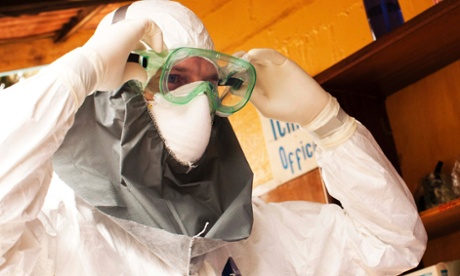Chief medical officer says Australia has ‘sophisticated, high-end capability’ for handling and outbreak

It is highly unlikely that the deadly Ebola virus would reach Australia, but if it did the country would be well prepared to respond, medical experts say.
“While the possibility of Ebola coming to Australia is very low, we are closely monitoring the overseas outbreak and Australia’s domestic response,” Australia’s chief medical officer, Professor Chris Baggoley, said in a statement.
There have been 1,201 cases of Ebola and 672 deaths in Guinea, Liberia and Sierra Leone since March, says the World Health Organisation (WHO), which has warned that drastic action is needed to stop the virus from spreading internationally.
Ebola has a 90% fatality rate and, once contracted, can kill victims in days.
There is no cure for the virus, which causes severe fever and muscle pain, vomiting, diarrhoea and, in some cases, organ failure and unstoppable bleeding.
Australia has started taking steps to prevent it arriving by warning on Tuesday against travel to Guinea, Liberia and Sierra Leone.
Baggoley said all border protection agencies were on alert to look out for the possibility of Ebola when identifying a person landing in Australia who is unwell.
He said on Tuesday a meeting was convened of the communicable diseases network of Australia, consisting of the key infectious diseases doctors, with all state and territory health authorities represented to discuss the possibility of the disease coming to Australia and ways to respond.
If Ebola reached here, Australia would be well placed to respond, he said.
“If in fact there was a suspected case, Australia has sophisticated, high-end laboratory diagnostic capability at physical containment level 4 [the highest level], which provides laboratory space, testing facilities, diagnostic methods, and highly trained virology and medical science staff capable of handling Ebola and other viruses that cause viral haemorrhagic fever.”
University of Sydney’s Professor Edward Holmes, an evolutionary biologist who has worked on viruses and other microbes for more than 20 years, agreed that there was a slim chance the virus could reach Australia.
“Essentially all viruses are able to move because people move,” he said. “There is always a chance – I’d say at the moment that chance is slim because it’s confined to three countries in West Africa.”
He said the risk of passing on the disease, even for people coming from Africa, was low.
The virus is passed on by body fluids, requiring close contact for someone to become infected.
“It’s not like a flu that spreads via airborne droplets,” he said. “That’s why a lot of the people who have become sick are medical workers who are intimately connected to the patients.”
